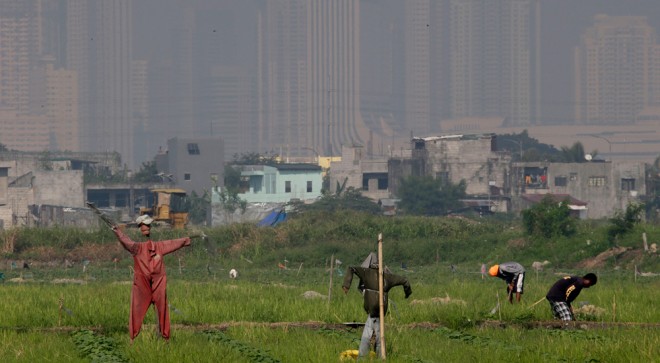Air pollution at highest levels ever in Metro on New Year’s

Farmers till their land amid thick smog from the previous night’s New Year revelry Wednesday Jan. 1, 2014, in Taguig City, which recorded the fourth-highest level of PM10 (1,150 ug/Ncm measured at 4 a.m.) in Metro Manila, according to Environment Secretary Ramon Paje. AP PHOTO/BULLIT MARQUEZ
MANILA, Philippines—As the dust from the New Year merrymaking settled, literally, environment officials found that the fireworks had caused nearly 10 times as much air pollution as is considered healthy in Metro Manila.
The Department of Environment and Natural Resources (DENR) said it recorded unnaturally high readings of particulate matter 10 microns and below in diameter, or PM10, which is used to measure air quality, in Metro Manila at the height of the New Year revelry.
The average reading was 1,437 ug/Ncm (micrograms per normal cubic meter of air), “way beyond” the average healthy value of 150 ug/Ncm set by the government and the World Health Organization, Environment Secretary Ramon Paje said in a statement.
Three times higher
Article continues after this advertisement
It was also three times higher than 2013’s unhealthy reading of 537 ug/Ncm, Paje added.
Article continues after this advertisementThe DENR regularly monitors Metro Manila’s air quality and pays particular attention to pollution levels during the New Year celebration.
Firecrackers and fireworks are a big part of the festivities in the Philippines as many Filipinos believe that making loud noise to greet the New Year brings good fortune.
Paje said the two highest levels of PM10—indicating the most polluted hours—were recorded in Quezon City at 1 a.m. in the vicinity of Ateneo de Manila University on Katipunan Avenue at 1,990 ug/Ncm, and the intersection of Edsa and Timog Avenue at 1,450 ug/Ncm.
These were followed by the 1,160 ug/Ncm measured also at 1 a.m. in Valenzuela City, and the 1,150 ug/Ncm measured at 4 a.m. in Taguig City.
Limiting fireworks
Paje expressed support for the proposal of the Department of Health to limit the use of fireworks as a community activity to designated areas only.
“While the DOH proposal is to reduce the impact of firecrackers on people, this will also benefit the environment in terms of reducing air pollution as the DENR could help in finding the right places for the activity,” Paje said.
When lit, firecrackers release a large amount of toxic particles that can easily enter the lungs and damage the respiratory system, Paje said, adding that the smoke contains sulphur, heavy metals and harmful fumes that could affect people with asthma and other ailments.
The impact of firecrackers on the environment is also considerable, such as making bodies of water acidic, depleting the nutrients in the soil, killing small animals and affecting the biodiversity of ecosystems.
“While the DENR is the government agency responsible for the implementation of Republic Act No. 8749, or the Clean Air Act, other government agencies as well as strong public support are the key to the success in reducing air pollution to government standards,” Paje said.
Related stories
WHO agency: Air pollution causes cancer
Experts warn: Watch out for air pollution, harmful gases from firecrackers
Originally posted: 10:49 pm | Thursday, January 2nd, 2014